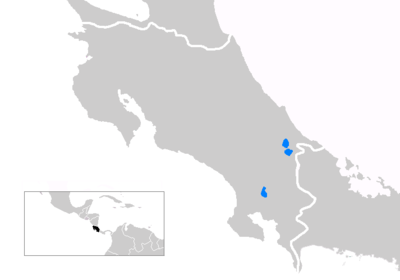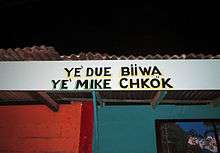Bribri language
Bribri, also known as Bri-bri, Bribriwak, and Bribri-wak, belongs to the Chibchan languages. This language family is indigenous to the Isthmo-Colombian Area, which extends from eastern Honduras to northern Colombia and includes populations of these countries as well as Nicaragua, Costa Rica, and Panama. As of 2002, there were about 11,000 speakers left.[3] An estimate by the National Census of Costa Rica in 2011 found that Bribri is currently spoken by 54.7% of the 12,785 Bribri people, about 7,000 individuals.[4] It is a tonal SOV language. There are three traditional dialects of Bribri: Coroma (in the western region of the Talamanca mountain range), Amubre (in the eastern region of the Talamanca mountain range) and Salitre (in the South Pacific area). Bribri is a tribal name, deriving from a word for "mountainous" in their own language. The Bribri language is also referred to as Su Uhtuk, which means "our language."[5] Bribri is reportedly most similar to sister language Cabécar as both languages have nasal harmony, but the two are mutually unintelligible.[6]
| Bribri | |
|---|---|
| Talamanca | |
| Native to | Costa Rica. |
| Region | Limón province: Talamanca cantón, along Lari, Telire, and Uren rivers; Puntarenas province: Buenos Aires cantón |
| Ethnicity | 12,200 Bribri people (2000)[1] |
Native speakers | 7,000 (2011)[1] 11,000 (2000) |
| Language codes | |
| ISO 639-3 | bzd |
| Glottolog | brib1243[2] |
 | |
Phonology
Consonants
| Bilabial | Dental | Alveolar | Retroflex | Palatal | Postalveolar | Velar | Glottal | ||
|---|---|---|---|---|---|---|---|---|---|
| Plosive | p b | t | t͡ʃ | k | ʔ | ||||
| Nasal | m | n | ɲ | ŋ | |||||
| Trill | r | ||||||||
| Flap | t͡s | ||||||||
| Fricative | d | d͡ʒ | h | ||||||
| Affricate | t͡k | s | ʃ | ||||||
| Approximant | ɹ | ||||||||
Vowels
I, u and a are pronounced in the same manner as they would be in Spanish. E and o are more open than in Spanish. The sound of ë is between i and e, in the same manner as ö is between u and o. The nasal vowels are pronounced similarly to the corresponding orals, with the addition of some air exiting through the nose.
Oral Vowels
| Front | Central | Back | |
|---|---|---|---|
| High | i | u | |
| Mid-high | ë | ö | |
| Mid-low | e | o | |
| Low | a |
Nasal Vowels
| Front | Central | Back | |
|---|---|---|---|
| High | ĩ | ũ | |
| Mid-high | |||
| Mid-low | ẽ | õ | |
| Low | ã |
| yì
¿quién? |
ù
casa | |
| yë
padre, papá |
tö
sí | |
| ye'
yo |
só
cucaracha | |
| awá
médico |
| mĩ
madre, mamá |
ũ
olla | |
| sẽ
eso, ese |
mõ
nube | |
| ã
en; para |
Writing System
The Linguistics Department at the University of Costa Rica has conceived a standardized spelling system, based on several earlier attempts.[7]

| a | b | d | ch | e | ë | i | j | k | l | m | n | ñ | o | ö | p | pp | r | rr | s | sh | t | tt | tch | ts | u | y | ꞌ |
Nasal vowels are indicated by a tilde: ⟨ã, ẽ, ĩ, õ, ũ⟩ (Previously indicated with a macron below: a̱, e̱, i̱, o̱, u̱), except after a nasal consonant (already indicating nasalisation of the vowel).
Tones are indicated by the grave accent for the high tone and the acute accent for the low tone; these can also be placed on the nasal vowels.
See also
References
- Bribri at Ethnologue (18th ed., 2015)
- Hammarström, Harald; Forkel, Robert; Haspelmath, Martin, eds. (2017). "Bribri". Glottolog 3.0. Jena, Germany: Max Planck Institute for the Science of Human History.
- "Ethnologue". Archived from the original on 28 June 2011. Retrieved 22 February 2011.
- "Vista de Morfología verbal de la lengua bribri". revistas.ucr.ac.cr. Retrieved 2020-01-29.
- "Bribri Language and the Bribri Indian Tribe (Bri-Bri, Talamanca, Coroma)". www.native-languages.org. Retrieved 2020-01-29.
- "Bribri". Ethnologue. Retrieved 2020-01-29.
- Jara & García 2013.
Bibliography
- Constenla Umaña, Adolfo; Feliciano Elizondo Figueroa og Francisco Pereira Mora (1998). Curso básico de bribri. San José, Costa Rica: Editorial de la Universidad de Costa Rica.CS1 maint: uses authors parameter (link)
- Constenla Umaña, Adolfo (1991). Las lenguas del área intermedia: Introducción a su estudio areal. San José, Costa Rica: Editorial de la Universidad de Costa Rica.
- Constenla Umaña, Adolfo (2008). "Estado actual de la subclasificación de las lenguas chibchenses y de la reconstrucción fonológica y gramatical del protochibchense". Estudios de Lingüística Chibcha. San José, Costa Rica. 27: 117–135.
- García Miguel; José María (1999). "La expresión de actantes centrales en español (romance) y bribri (chibcha): tipología, discurso y cognición" (PDF). Actas do 1º Encontro de Lingüística Cognitiva. Faculdade de Letras do Porto: 101–121.
- Jara Murillo; Carla Victoria (1993). I ttè. Historias bribris. San José, Costa Rica: Editorial de la Universidad de Costa Rica.
- Jara Murillo; Carla Victoria (2013). "Morfología verbal de la lengua bribri". Estudios de Lingüística Chibcha. San José, Costa Rica. 32: 95–152.
- Jara Murillo, Carla Victoria og Alí García Segura (1997). Kó késka. El lugar del tiempo. San José, Costa Rica: Editorial de la Universidad de Costa Rica.CS1 maint: uses authors parameter (link)
- Jara Murillo, Carla Victoria og Alí García Segura (2009). Se' ẽ' yawö bribri wa. Aprendemos la lengua bribri. San José, Costa Rica: Universidad de Costa Rica – UNICEF.CS1 maint: uses authors parameter (link)
- Jara Murillo, Carla Victoria og Alí García Segura (2013). Se' ttö́ bribri ie. Hablemos en bribri. San José, Costa Rica: E-Digital.CS1 maint: uses authors parameter (link)
- Krohn, Haakon Stensrud (2014). "Semántica de los clasificadores numerales en el bribri de Coroma". Estudios de Lingüística Chibcha. San José, Costa Rica. 33: 209–239.
- Margery Peña, Enrique (1982). Diccionario fraseológico bribri–español español–bribri. San José, Costa Rica: Editorial de la Universidad de Costa Rica.
- Quesada, J. Diego (2007). The Chibchan languages. Cartago, Costa Rica: Editorial Tecnológica de Costa Rica.
- Sánchez Avendaño, Carlos (2009). "La voz media en bribri y la hipótesis de la elaboración relativa de los eventos". Estudios de Lingüística Chibcha. San José, Costa Rica. 28: 47–73.
- Tohsaku, Y.-H. (1987). "Bribri nasal harmony from the vantage point of the universal theory of harmony". Working Papers of the Linguistic Circle of the University of Victoria. 6 (1): 1–10.
External links
| Bribri language test of Wikipedia at Wikimedia Incubator |
- Portal de la lengua bribri. Bribri texts, audios and transcriptions, by Carla V. Jara and Alí García Segura
- Bribri's entry on the WALS
- A Bribri course with audio files: Jara Murillo, Carla con Alí García Segura. 2008. Materiales y Ejercicios para el Curso de Bribri I, Universidad de Costa Rica.
- Recordings of Bribri conversations and narratives from the Indigenous Languages of Costa Rica Collection of Laura Cervantes at AILLA.